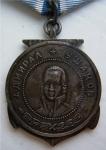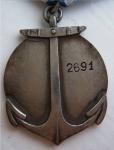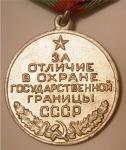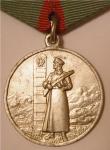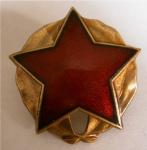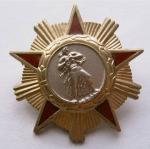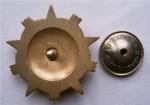-
Posts
585 -
Joined
-
Last visited
Content Type
Profiles
Forums
Blogs
Gallery
Events
Store
Everything posted by Belaruski
-
I think I'm going off the undertheredstar website with that star on the crown thing, but everyone makes mistakes! Do modern train personell wear such 'militaristic' uniforms?
-

Fake Is this Soviet ODM real or not?
Belaruski replied to usairforce's topic in Russia: Soviet Orders, Medals & Decorations
Excellent idea. I'll start us off with this one. A medal of Ushakov. I've already a pretty good idea, and I'll be interested to hear the replies! Incidentaly it is made of silver, and is two pieces. -

Soviet RKKA Sgt - Circa 1945
Belaruski replied to RichieC's topic in Russia: Soviet: Other Militaria
I think Takc has a good point here. It's not 'faking' to put the right buttons on. Faking would be the adding of a Vlasov ROA sleevepatch for example. -
True enough. I bought this one probably about 10 years ago, at a time when I presumed only the 'big ones' were faked. But as I said you live and learn. I have a few fake top orders that I'm happy with as good display items, and this will have to join them! My budget is now slowly excluding me from Soviet stuff!
-

Soviet Soviet Officers' Insignia, 1930s+
Belaruski replied to a topic in Russia: Soviet: Other Militaria
Rick those scout insignia from post #5 are superb! Let me know (Please!!) if you ever decide to sell them! -

Soviet Market for Soviet awards in Belarus
Belaruski replied to Bob's topic in Russia: Soviet Orders, Medals & Decorations
The law on buying and selling of Soviet awards in Belarus is now quite severe. If I remember rightly it is 2 years in prison! (up to). Whilst you're there though, can you pick me up some odern Belarusian medals?! -

Soviet Order of Red Star #68121
Belaruski replied to deptfordboy's topic in Russia: Soviet Orders, Medals & Decorations
A good find Gilbert! Can you show a close up of the modified screwpost? I'm intrigued! I'm trying to work out why that would have been done. -

Soviet RKKA Sgt - Circa 1945
Belaruski replied to RichieC's topic in Russia: Soviet: Other Militaria
That's in very nice salty condition! I have a 41' greatcoat too, but an officers one. I'm glad I bought it though as yours is the only other one I've 'seen' since. -
Very nice Takc! Soviet made I presume?
-
As I understand it the star ought to be on the crown if this a 70's or 80's cap. However I think the visor itself is older than that. I still think the badge is a modified one. I'll show you a very interesting version of this cap tomorrow when the sun comes up!
-

Soviet Soviet Naval Officers daggers
Belaruski replied to Hauptmann's topic in Russia: Soviet: Other Militaria
My 'translation' Admiral Ivan Ivanovich Baikov: the commander of Leningrad naval base from January 1961 until December 1971. He was borne on 16 September, 1906, in St. Petersburg. From October 1927 until February 1931 he studied at the naval school 'M. V. of Frunze', after the end of which he was appointed as the mine layer of submarine "Red Guard". From December 1931 until May 1932 he learned in the command class of the training force of underwater operations in Leningrad. During May 1932 he was appointed as the second in command of the submarine "Proletarian". From September 1933 he was the commander of submarine "M16", which was part of the Pacific fleet. During March 1936 he was appointed as the commander of the submarine division of Pacific fleet. From May 1938 chief of staff, while from October 1939 the commander of the brigade of submarines in the same fleet. During April 1942 he was assigned to be the deputy chief of staff of Pacific Ocean fleet. From August 1943 the chief of staff of North Pacific Ocean flotilla. On 5 November, 1944, he was awarded title rear admiral. From July 1946 he commanded Sakhalin military flotilla. During January 1947 he was assigned to command the 7th VMF, and awarded the title Vice Admiral. From October 1951 through February 1953 he studied in the naval department of the highest military academy, after which was appointed as the commandant of Kronstadt naval fortress. On 8 August, 1955, was awarded title full Admiral. On the basis of order № 002 of 4 January, 1956, of Minister of Defense, Kronstadt naval fortress and Leningrad naval base were united into the Leningrad naval region. By order № 0207 of 25 January, 1956, of the commander-in-chief OF VMF of the commander of region was assigned Admiral I. i. baykov. For the execution of the directive № OF ORG/SHCH/'0'9YA of 16 March, 1960, of the Minister of Defense OF THE USSR Leningrad naval region was re-formed into the Leningrad naval base with the subordination to the commander-in-chief OF VMF. The commander of Leningrad naval base and the commandant of Kronstadt naval fortress was Admiral I. i. Baykov. He resigned in January 1972, and passed away on 23 March, 1992, in Saint Petersburg. He was buried at the Serafimovskom cemetery. Was awarded: four Order of Lenins (1935, 1951, 1957, 1967), the order of October Revolution (1976), three Order of the Red Banners (1945, 1946, 1956), two Order of the Patriotic Wars I class. (1946, 1985), the Order of the Red Banner of Labor (1966), two Order of the Red Stars (1943,1944), medals, and an honour weapon. -

Soviet RKKA Sgt - Circa 1945
Belaruski replied to RichieC's topic in Russia: Soviet: Other Militaria
I hadn't noticed the collar patches were 'upside down'. A case of me looking and not seeing. Incidentally Richie a lovely greatcoat. It's nice to see these old 'bald' coats! -

Albania Order of the Partisan Star
Belaruski replied to Bob's topic in Southern European & Balkan States
Here's my newly arrived first class. An absolutely beautiful but simple award! Also a close up of the small " ^ " from the reverse of the points. -
Richie, interesting cap! The sequins are a very unusual touch! From my very limited experience of bullion embroiding they appear to have been added by hand with the original wire possibly removed. Or the whole badge could be a custom job for an individual. Very interesting though! Where do you find all of your furazhkas!?
-
Here's mine. Possibly another manufacturing variation? The 'bowl' in the back boes not have a flat bottom as others appear to, but that may be due to the angle of the photographs, screwnut markings etc. But the Prawema screwplate is different to the above ones, with a nice beaded raised edge. Again the central medallion is aligned with nothing but itself (like Albania!). ((and no small 6 o'clock position mark on the reverse))
-
Hello Takc! nice to see you here!
-

Soviet Soviet & Eastern Block Quiz
Belaruski replied to Christophe's topic in Russia: Soviet: Other Militaria
No idea on the nickname. But Klementi Voroshilov had a heavy tank named after him, and was an old Bolshevik who rose to become the chairman of the Soviet presidium. The armour on the tank was made lighter because it was thick all around and thus impeded mobility. Most tanks need thick armour on the front where they ought to be getting hit if at all, then thinner on the sides and thinnest on the back. Thus still gaining the balance between armour and mobility. -

Albania Albanian Cap Star.
Belaruski replied to Belaruski's topic in Southern European & Balkan States
I may be able to get you one, I'll ask. -

Soviet VVS Mechanic's School badge? Opinions please
Belaruski replied to shako_uk's topic in Russia: Soviet: Other Militaria
This book is M Furlan's Soviet Army Insignia: An illustrated guide for collectors. It was first published in 1990, and as such it has to be said that it is far from complete, and occasionaly innacurate. The best example being the picture of a Khasan battle badge labelled as being issued in 1934. Now Soviet intelligence was good, but not THAT good.. -
A very interesting badge! I wonder why the 'cutout' areas are so random?
-
Thanks for your work Richie!




